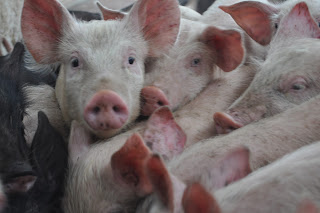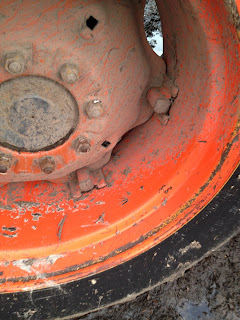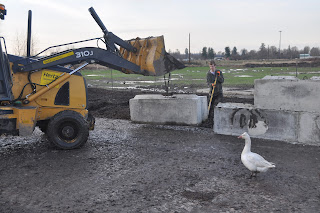First, I'd like to say that I own two kubota tractors, and I don't own a single John Deere. And I use those kubota tractors every day for a variety of things; in fact, my two farmhands use them every day.
Every day... I'm say that we put 200 hours of running time a month on each tractor. We love our tractors.
This is the way a wheel looks when it's not broken. This is the front wheel. In the center right of the picture, notice a square headed bolt. A bunch of those is what holds the outer part of the tractor wheel to the inner hub, which is attached to the axle.
This is what it looks like when the mount for that bolt breaks off. In fact, most of the mounts broke off on one tire, and the tire fell off the tractor. This is a 1996 Kubota 9850, so this particular part might be original equipment; but even so, I wouldn't expect a WHEEL to come apart like this. Think about your car -- how often does the steel part of the wheel on your car break? So I'm not happy about this to begin with.
So I call the Kubota dealer that I work with, and the parts guy takes the tire size, and I ask him for a price and a leadtime -- I can either replace this part, or weld it back together. I'm leaning towards welding anyway, but I want to know what it would cost. I'm figuring $300 or $400, something like that.
Kubota no longer makes this part. You can't buy a new one.
(When they did sell these, they cost $1200. Each. You'd think that $1200 per wheel would keep them in stock. Nope. )
The American ethos for tractors is that you keep them forever, basically. Once they've had a useful life on your farm, they'll tend to go to anther farm, and another one. A john deere 8N tractor made in the 50s is a pretty common sight in the country. That's a tractor that is 60 years old. You can buy spare parts for it. Heck, if you break the frame, you can still buy the cast iron parts.
But Kubota seems to have the opinion that they'll support their tractors with spare parts for...what? 10 years? 15? And if it breaks after that, you're out of luck.
Yes, I can probably find a wheel somewhere off some dead tractor, or weld this one back together, but this is the SECOND time that I've had some part of this tractor break and been told that they no longer sell it.
Summary? If I were in the market for a used tractor, I think I'd buy green. Because I can get the parts I need to keep it running.
And I'm saying that as a satisfied customer of Kubota. When they're not broken they are really nice tractors and do a good job. But when they do break it's an emergency to get the PARTS to fix it any more. It's already an emergency to have the tractor broken -- I don't need this sort of help.
I did call the Kubota Guy back, and asked him to relay this feedback to Kubota:
1) When you stop making a particular part, search through the parts for other tractors and see if another part will fit. In this case, there may be another kubota tractor that uses this size wheel and lug pattern -- but there's no easy way for the dealer to find it.
2) If they can't find it, and it's no longer made, I can't give the dealer any more money. The dealer would like to have my money. I'd like to support the dealer. Neither of us like not having a part for a working tractor.
3) Reconsider the lifespan of your tractors, particularly in the American Market. All things equal, I could be using this tractor on my farm for another 10 years. And the guy who buys it from me for another 10. 10 to 15 years is WAAAY shorter than the average farm tractor lifespan in the US.
4) Look at what your competitor is doing, and consider that I'm a tractor buyer and user. I'm going to have a serious bias AGAINST kubotas next time I purchase.






















































